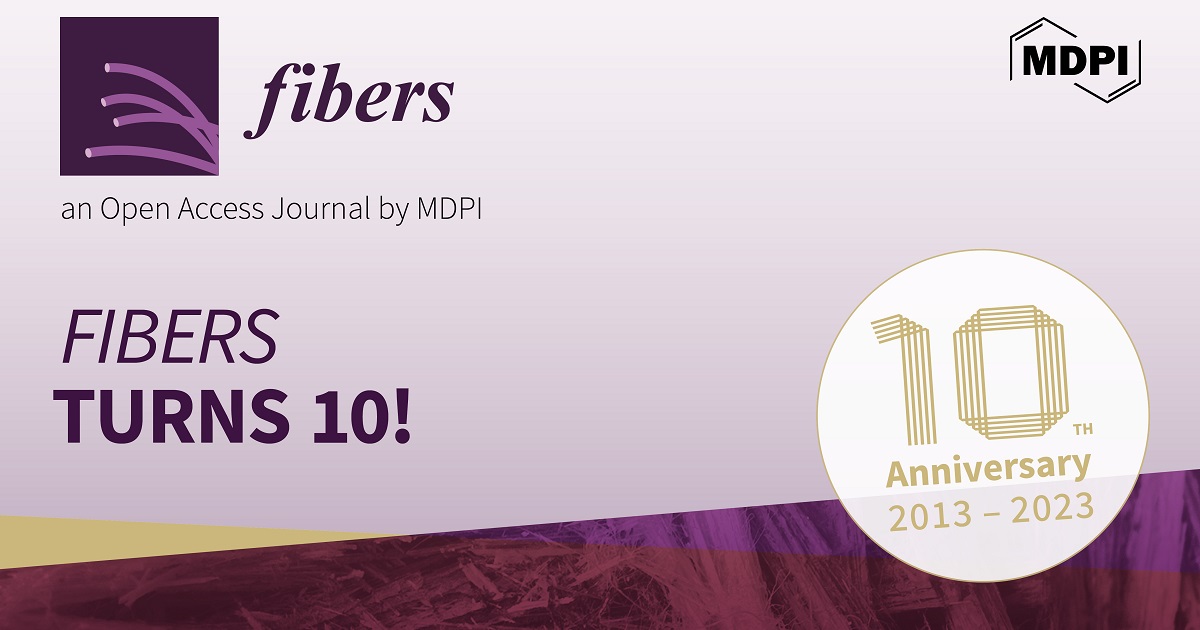- 3.9Impact Factor
- 7.4CiteScore
- 24 daysTime to First Decision
Fibers 10th Anniversary: Past, Present, and Future
Special Issue Information
Dear Colleagues,
The year 2023 marks the 10th year of the journal Fibers, and we invite you to join us in celebrating its anniversary. To this end, the journal will publish an anniversary Special Issue, “Fibers 10th Anniversary: Past, Present, and Future”. We invite you to submit an original article reflecting your latest work related to fiber research. We also welcome reviews of past and current research, and future perspectives. Editors, authors, and reviewers who have made contributions to Fibers are particularly invited to contribute. Topics of interest include, but are not limited to: fiber and fiber-based materials’ properties, the design of fibrous materials, biocompatibility, toxicology and environmental safety, and the processing of fibers and any aspect of fibrous materials.
Fibers released its inaugural issue in 2013, with the founding Editor-in-Chief Prof. Dr. Stephen C. Bondy. Fibers was indexed in the Emerging Sources Citation Index, Web of Science (Clarivate Analytics) and Scopus, Elsevier in 2015 and 2017, respectively, and received its first CiteScore of 2.5 in 2018. In the same year, we welcomed our new Editor-in-Chief, Prof. Dr. Martin J. D. Clift. By the end of 2022, Fibers published more than 600 high-quality original articles, which is reflected in its current CiteScore rising to 6.5 (Q1 in Civil and Structural Engineering). The journal has more than 100 Editorial Board Members and over 1300 reviewers.
Prof. Dr. Catalin R. Picu
Prof. Dr. Lucian Lucia
Guest Editors
Manuscript Submission Information
Manuscripts should be submitted online at www.mdpi.com by registering and logging in to this website. Once you are registered, click here to go to the submission form. Manuscripts can be submitted until the deadline. All submissions that pass pre-check are peer-reviewed. Accepted papers will be published continuously in the journal (as soon as accepted) and will be listed together on the special issue website. Research articles, review articles as well as short communications are invited. For planned papers, a title and short abstract (about 250 words) can be sent to the Editorial Office for assessment.
Submitted manuscripts should not have been published previously, nor be under consideration for publication elsewhere (except conference proceedings papers). All manuscripts are thoroughly refereed through a single-blind peer-review process. A guide for authors and other relevant information for submission of manuscripts is available on the Instructions for Authors page. Fibers is an international peer-reviewed open access monthly journal published by MDPI.
Please visit the Instructions for Authors page before submitting a manuscript. The Article Processing Charge (APC) for publication in this open access journal is 2000 CHF (Swiss Francs). Submitted papers should be well formatted and use good English. Authors may use MDPI's English editing service prior to publication or during author revisions.
Keywords
- polymer fibers
- carbon fibers
- nanofibers
- optical fibers
- glass fibers
- nanotubes
- plant fibers
- cellulose
- animal fibers
- mineral fibers
- synthetic fibers
- textile fibers
- fibers reinforcement
- fibers preparation, origins, processing
- fibers treatment, modification
- fibers structure, properties, toxicology
- fibers application
- other topics and technologies related to fibers

Benefits of Publishing in a Special Issue
- Ease of navigation: Grouping papers by topic helps scholars navigate broad scope journals more efficiently.
- Greater discoverability: Special Issues support the reach and impact of scientific research. Articles in Special Issues are more discoverable and cited more frequently.
- Expansion of research network: Special Issues facilitate connections among authors, fostering scientific collaborations.
- External promotion: Articles in Special Issues are often promoted through the journal's social media, increasing their visibility.
- e-Book format: Special Issues with more than 10 articles can be published as dedicated e-books, ensuring wide and rapid dissemination.

